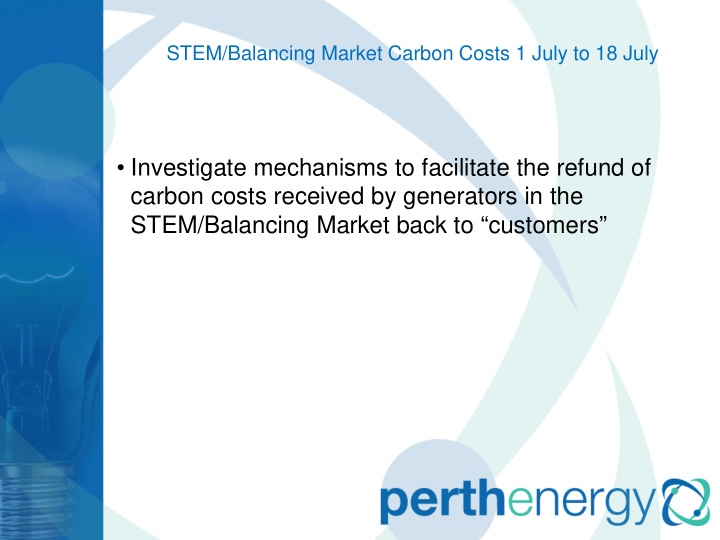



STEM/Balancing Market Carbon Costs 1 July to 18 July • Investigate mechanisms to facilitate the refund of carbon costs received by generators in the STEM/Balancing Market back to “customers”
STEM/Balancing Market Carbon Costs 1 July to 18 July • Carbon Tax repeal background information – All suppliers of regulated goods must pass through all their costs savings directly or indirectly attributable to the carbon tax repeal to customers. Suppliers of regulated goods that do not pass through all carbon tax costs savings are engaging in price exploitation, which is against the law. – Regulated goods include electricity and natural gas – A supplier of a regulated good includes: • an entity who holds a retail or integrated regional licence within the meaning of the Electricity Industry Act 2004; and • Any other entity who produces electricity in Australia – Carbon tax repeal was retrospective to 1 July 2014 • Generators must pass through all their “cost savings” directly or indirectly attributable to the carbon tax repeal to “customers” • The ACCC has advised that in WA, “customers” of Generators include Bilateral Contract counterparties and “Market Customers” under the Market Rules. • Generators must reasonably attribute any “cost savings” to the different “customers” that the entity has (ie Bilateral Contract counterparties and Market Customers);
STEM/Balancing Market Carbon Costs 1 July to 18 July • Generators must provide the ACCC and each of its “customers” a Carbon Tax Removal Substantiation Statement that details the entity’s estimate, “on an average percentage price basis, or an average annual dollar price basis” of the cost savings attributable to the carbon tax repeal. • IMO can help facilitate the identification of “Market Customers”: – Provide each participant with their net market purchases for the retrospective period – the difference between Metered Load and Bilateral position – It is up to each participant that is a net seller to determine if and how much cost savings is attributable to Market Customers. • IMO can help facilitate the funds transfers – The IMO can collect the funds from the net sellers and remit to the net buyers based on the market data above – there maybe some additional costs/oversight required or – Each net buyer authorises the IMO to inform each net seller of the net buyers percentage of market purchases – then each seller contacts each buyer to complete funds transfer • Constrained Payment carbon costs can be handled this way as well. • IMO does not do any carbon intensity calculations – any refunds are determined by generators, subject to their obligations to the ACCC
Recommend
More recommend